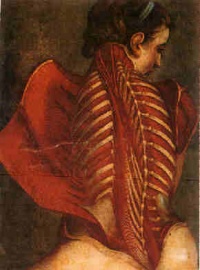Human body
From The Art and Popular Culture Encyclopedia

|
Related e |
|
Featured: |
- See Mikhail Bakhtin's concept of the grotesque body and notes on an embodied philosophy.
With regard to living things, a body is the integral physical material of an individual, and contrasts with soul, personality and behavior. In some contexts, a superficial element of a body, such as hair may be regarded as not a part of it, even while attached. The same is true of excretable substances, such as stool, both while residing in the body and afterwards. Plants composed of more than one cell are not normally regarded as possessing a body.
"Body" often is used in connection with appearance, health issues and death. The body of a dead person is also called a corpse, for humans, or cadaver. The dead bodies of vertebrate animals and insects are sometimes called carcasses.
The study of the structure of the body is called anatomy. The study of the workings of the body is physiology.
The human body consists of a head, neck, torso, two arms and two legs.
A body is also a held-together collection or group of physical objects or abstract ideas and, in particular, an organisation of such. The whole is more than the simple sum of the individual members, because the whole contains, in addition, information about the relationships among the elements of the whole. The body of evidence is a phrase which defines the sum total of all knowledge or evidence of some thing.
Body Ecology focuses on the interactions among animals and various microbes living inside them.
There are 206 different bones in the human body, and over 600 muscles.
See also
- Anatomy
- Bodily function
- Body parts
- Body politics
- Body genres
- Disease
- Embodied philosophy
- Grotesque body
- Somatopia
- Health
- Orifice
- Ugliness
,_Utriusque_cosmic_maioris_scilicet_et_minoris_metaphysica.jpg)

